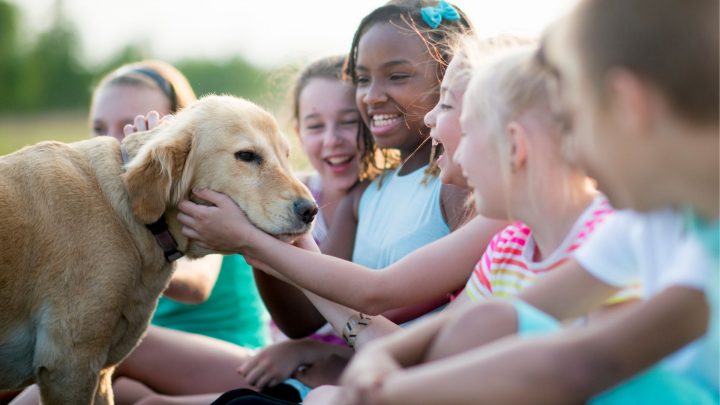Encouraging empathy and compassion includes being a role model, correcting inappropriate behavior, being consistent, and positively reinforcing behavior.

Table of Contents
- Educating Children About Pet Compassion and Safety
- Approaches to Encouraging Empathy and Compassion
- Choose Media that Present Desired Behaviors
- FAQs
Educating Children About Pet Compassion and Safety
The kids are back to school and that means more learning and growth for all. One subject that doesn’t get enough time in the classroom is compassion, both for fellow humans and for pets and other animals in our lives. We cares deeply about the care and safety of all animals. That’s why we’ve put together these thoughts about how to bring extra learning into the family, taking the time to learn and teach about compassion and safety for the animals (and people) we encounter.
When you own a pet, the responsibility of teaching and learning goes both ways between children and pets. For example, children learn how to feed and care for furry friends and, in turn, what it means to care for another living being outside themselves. Realizing that others have feelings, and that our actions impact those feelings, is the first step. That’s called empathy–the ability to understand and share the feelings of others.
Approaches to Encouraging Empathy and Compassion
Like many social skills, there is a spectrum of empathy and compassion. Not everyone is born with a lot, while others have it in spades without even trying. You can probably think of the people in your life with loads of empathy. And hopefully, you can have compassion for those that don’t. Thankfully, empathy can be taught in a variety of ways.
Not surprisingly, successfully teaching and encouraging empathy and compassion employs some of the same techniques you might have used to teach your dog or cat how you want them to behave. That includes being a good role model, positively correcting inappropriate behavior, being consistent, and selectively choosing examples that reinforce the desired behaviors.
Be A Role Model
Even when we’re not in ‘teacher mode’ and we don’t even think they are paying attention, children are learning from our behavior. Modeling the behavior you desire in them is perhaps the most important way to encourage empathy and compassion. We can be positive models for children in simple ways. Taking spiders, flies and bees outside instead of killing them is one example. Giving space, talking kindly, helping or gently petting an injured or shy animal is another. This encourages kindness while being mindful of the animal’s personality and abilities. Many children will be able to generalize and apply this approach to interacting with humans, such as a classmate with a broken arm or someone who uses a wheelchair.
Reinforce Positive Behavior
Just as we might give a dog a treat when she sits on command, we must notice and praise children when they are doing the behavior we desire. That can come in the form of direct verbal praise in the moment, “I notice how sweet and gentle you’re being with Mitsy,” or “Wow, you were so compassionate when you checked Mitten’s paw.”
Children can also be rewarded with additional time and attention with an animal, friend or an adult when they show compassion and empathy for animals. Most children respond well to positive attention from others and are willing to do those behaviors again, without even thinking about it.
Gently Correct Inappropriate Behavior
Remembering that everyone’s empathy and compassion fall on a spectrum, that means that some children (and adults) may not be able to learn or generalize from role models. Those individuals might need our help with gentle correction. Just like training an animal, gentle correction needs to be pretty immediate, depending on the age of individual, to be effective.
Preschoolers and kinders need correction within a few minutes or they won’t remember what happened. While safety of the animals is paramount, the time to correction can increase proportionately with age. Often, gentle correction with middle and high schoolers is best done in private later the same day when time allows for deeper discussion and without distractions.
As you might have guessed, abrupt, shaming or correction that is too firm may not achieve the desired behavior. Some children respond to criticism that isn’t constructive in defensive ways. That means they might ignore your correction on purpose next time, or even act out negatively to get more of your attention, even if its your negative response. Be sure your response is calm, measured and deliberate. Take a break if needed to make sure you’re approaching the child with compassion and remembering that sometimes they can’t already know some of the things we take for granted.
Be Consistent
The developing brains of children (and animals) try to categorize the world, making observations and then rules about the way the world works. For example, when I wake up in the morning, I get dressed, make my bed, eat breakfast, wash my face and brush my teeth. If every morning is different for a child, they won’t build the connections between neurons in the brain that help them internalize, and automate, that routine. Being consistent, as a role model and with gentle correction, is very important to help children. If you are only gentle with animals sometimes, or their bad behavior goes without correction half the time, the nerve cells in their brain tell them that sometimes its okay to hit an animal when you’re feeling mad.
Take the break if you need it to be a good role model. Make the time in your busy schedule to talk about and correct inappropriate behavior. And be aware of the potential precedents you might be setting if you are being inconsistent in your responses.

Choose Media that Present Desired Behaviors
We won’t delve in to the heated debate here about whether or not video games and television shows effect empathy and compassion. But there is evidence that violence toward animals (and humans) in these and other forms of media can desensitize children, especially very young children who are still learning to differentiate between fantasy versus reality and ‘right’ versus ‘wrong.’
FAQs
The presence of dogs in a child’s life can create opportunities for meaningful lessons in compassion, empathy, and understanding. For instance, interacting with dogs teaches children the importance of treating others gently and respectfully. However, it’s important for parents and caregivers to supervise interactions between children and dogs to ensure the safety and well-being of both.
You can start by being a good role model. Treat your pets with love and respect, and explain your actions and feelings to your child. Discuss how animals have their own feelings, needs, and ways of communicating. Teach children to respect animals’ personal space and boundaries. Encourage children to demonstrate kindness towards animals and nature. Encourage open discussions, answer children’s questions, and foster an environment where animals are treated with kindness and respect.
Yes, having pets can be a wonderful way to teach kids empathy. Interacting with and caring for pets provides children with opportunities to develop a sense of compassion, understanding, and consideration for the feelings and needs of others.




